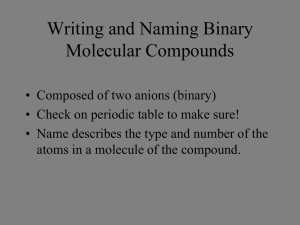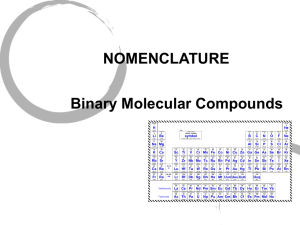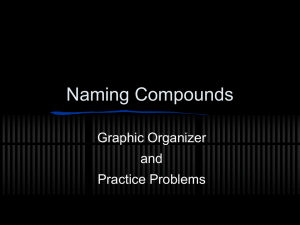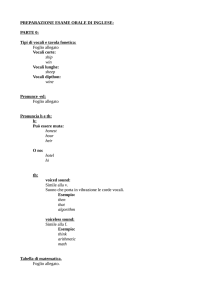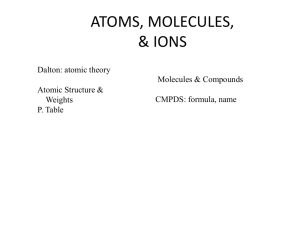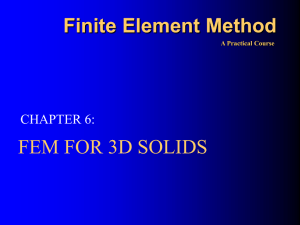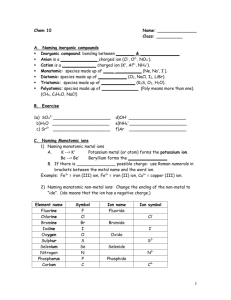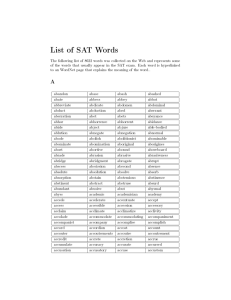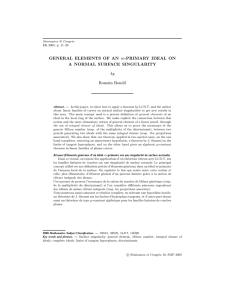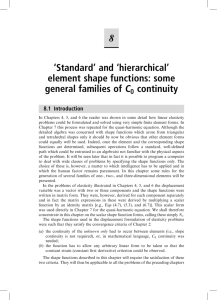Naming and Writing Formulas for Chemical Compounds
advertisement
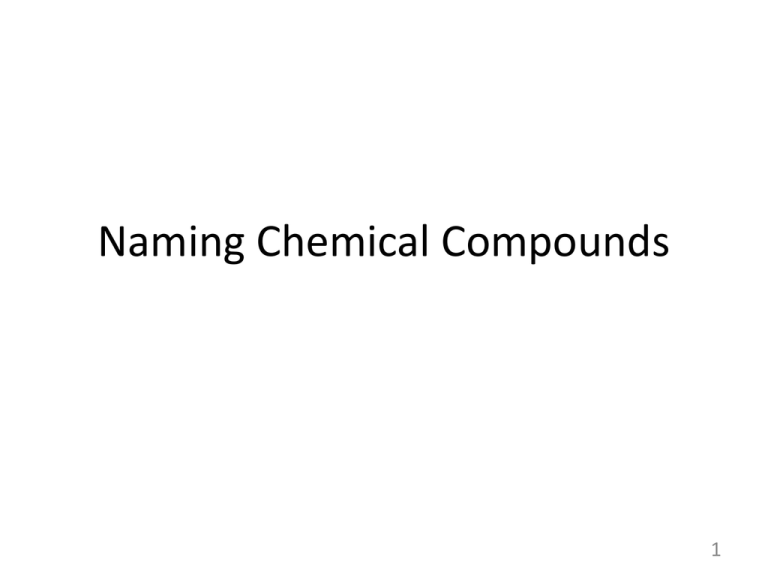
Naming Chemical Compounds 1 Ions: Naming and Formulas Naming: Cations (positive charge) • Single ion formation – Metals in groups 1,2,13 – Element Name + ion – ex. Ca+2 Calcium ion • Anions (negative charge) • Nonmetals – Root of Element –ide – ex. S-2 sulfide Multiple ion formation - Transition metals, Tin and Lead - Element Name (RN) + ion - Roman Numeral (RN) = charge - ex. Fe+3 Iron (III) ion • Formulas -- element symbol AND charge • Charge is determined by group number or roman numeral 2 Naming Binary Compounds – 2 Elements • Cation/1st element = name of element (always 1st) • Anion/2nd element = root of element + ide – Type I (Ionic) – cation only forms a single ion…. • Nothing added – Type II (Ionic) - cation forms multiple ions….. • roman numeral must be added (between cation and anion names) to indicate charge of the metal – Type III (covalent) – 1st element is a nonmetal … • Prefixes are used to indicate number of atoms for 1st and 2nd element • Mono- never used on 1st element 3 Type I (binary ionic) • Characteristics – 2 elements – Metal + Nonmetal – Metal found in groups 1,2,13,Zn+2,Ag+,Cd+2 • Rules – cation (+) named 1st, anion (-) named second – cation element name – anion root of element name + (-ide) *subscripts of chemical formulas are NOT indicated directly in compound name 4 Type II (binary ionic) • Characteristics – 2 elements – Metal + Nonmetal – Metal found in groups 3-12,Pb,Sn • Rules – cation (+) named 1st, anion (-) named second – cation element name (roman numeral) • roman numeral indicates the charge of the cation – anion root of element name + (-ide) *subscripts of chemical formulas are NOT indicated directly in compound name 5 Determining Charge for Roman Numerals • Total charge of + ions and – ions = 0 (# +ions)(charge +ions) + (# -ions)(charge –ions) = 0 Example: FeCl2 --- (1) Fe ion + (2 Cl)(-1) = 0 Fe ion + (-2) = 0 Fe ion = 2+ Cr2O3 ----- (2) Cr ion + (3 O) (-2) = 0 2 Cr ions + (- 6) = 0 2 Cr ions = 6+ Cr ion = 3+ = Cr3+ 6 Type III (binary covalent) • Characteristics – 2 elements – Nonmetal + Nonmetal • Rules – 1st element element name – 2nd element root of element name + (-ide) – Use prefixes on both elements to indicate the number of atoms (subscripts) • 1 (mono) 2 (di) 3 (tri) 4 (tetra) 5 (penta) 6 (hexa) 7 (hepta) 8 (octa) 9 (nona) 10 (deca) • NEVER use (mono) on the 1st element • No double vowels with “o” and “a” 7 Non-binary Ionic • Characteristics – 3 or more elements – contains a polyatomic ion • Rules – Cation • Metal (groups 1,2,13,Zn+2,Ag+,Cd+2) element name • Metal (groups 3-12, Pb, Sn) element name (roman numeral) • Polyatomic ion name on reference sheet – Anion • Nonmetal root of element name + (-ide) • Polyatomic ion name on reference sheet 8 Writing Formulas Elements and Compounds 9 Element Formulas • Monatomic Elements – Only the element symbol is used for the formula • Diatomic Elements – These elements can NOT exist in nature as single atoms, they must be paired. – They include: hydrogen (H2), nitrogen (N2), oxygen (O2), fluorine (F2), chlorine (Cl2), bromine (Br2), and iodine (I2). 10 Compound Formulas - Ionic • Ionic (metal and nonmetal) – Symbol • Elements – symbol on periodic table • Polyatomic ions – reference sheet – Charges • Group charges – 1(+1), 2(+2), 13(+3), 15(-3), 16(-2), 17(-1) • Roman numerals – charge of the transition metal • Polyatomic ions – reference sheet – Switch • total (+) = total (-) • Charge #’s cross down to become the subscripts on the other element – Reduce • Subscripts must be in smallest ratios 11 Compound Formulas – Covalent • Covalent (only nonmetals) – Convert prefixes to subscripts – place BEHIND the element symbol • Mono – 1 • Di – 2 • Tri – 3 • Tetra – 4 • Penta – 5 • Hexa – 6 • Hepta -7 • Octa – 8 • Nona – 9 • Deca - 10 12
